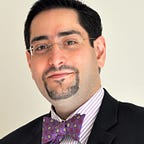Anti-Reflux barrier — How does your body prevent acid reflux?
In mid-nineteenth century and before the advent of modern endoscopes, Dr. Norman Barrett, a British thoracic surgeon, postulated the presence of a fold that functions as a flap valve between the esophagus and the stomach (gastroesophageal junction or GEJ) to prevent acid reflux. Eventually in 1996 Dr. Lucius Hill described and classified this gastroesophageal “flap valve.” Dr. Hill’s works resulted in inclusion of the flap valve in the Gray’s Anatomy reference book in 1999.
The flap valve is formed by the oblique angle at which the esophagus enters into and integrates with the stomach. GEJ is anchored under the diaphragm by phrenoesophageal ligaments. Lower esophageal sphincter is a muscle ring at the bottom of esophagus and is controlled by neural input. The sphincter and the valve work together and form a powerful anti-reflux barrier.
With each swallow, the esophageal body shortens and GEJ moves up. This dislocation results in opening of the flap valve and passage of the food into the stomach. After swallowing, stomach returns to its normal position under the diaphragm by the recoil of the phrenoesophageal ligaments.
In a normal individual, there is an acute angle between the esophagus and upper part of the stomach (fundus). This angle was described by Dr. Wilhem in the beginning of the 19th century and is named after him.
After the passage of food to the stomach, the GEJ closes to prevent the return of gastric fluid to the esophagus. This becomes possible by the contraction of the lower esophageal sphincter and closure of the flap valve. In the presence of an acute angle of His, the stomach fundus inflates by air and balloons up under the diaphragm dome after eating. The pressure from the inflated fundus transmits to the flap valve and seals the stomach.
The elasticity of the GEJ ligaments diminishes overtime due to ongoing wear-and-tear. As a result, the stomach loses its normal shape and becomes like a funnel. The Angle of His becomes obtuse and the flap valve fails. In the absence of an acute angle of His, the lower esophageal sphincter is the only anti-reflux mechanism and, usually, it fails too. This results in significant acid reflux and regurgitation.
Deterioration of the anti-reflux barrier is a gradual process: It starts by gradual loss of elasticity of the phrenoesophageal ligaments leading to gradual alteration of the stomach shape and progresses to continuous widening of the angle of His until the flap valve disappears and the lower esophageal sphincter eventually fails.
The next step in the natural progression of GERD is the formation of hiatal hernia. The upper part of the funnel-shaped stomach progressively displaces into the chest cavity after each swallow and does not completely return back to its original location under the diaphragm. The segment of the stomach that remains in the chest cavity is referred to as hiatal hernia.
Initially, this stomach segment can slide up and down freely (hence the term reducible or sliding hiatal hernia). Later, as the GERD progress, this portion of the stomach becomes fixed and stays permanently in the chest cavity. At this stage, the hiatal hernia is described as nonreducible hiatal hernia.
As the hiatal hernia increases in size, the esophagus continues to shrink and becomes more tortuous. This is believed to be caused by chronic inflammation, scar tissue formation or permanent spastic contraction of esophagus. Short esophagus syndrome and presbyesophagus (presby is Latin for old) are the terms used to describe the esophagus at this stage. Patients with these conditions commonly have difficulty swallowing and get the sensation of food stuck in their esophagus after eating.
Simply treating the GERD symptoms by medications for a long term without addressing the underlying anatomical problems, can lead to complete destruction of the flap valve, formation of a large nonreducible hiatal hernia and swallowing difficulties associated with short and tortuous esophagus.
When GERD progresses to such late stage, the medications do not subside the heartburn. There is significant regurgitation after eating and other organs such as throat, sinuses, and lungs gets affected by the acid reflux. Patients may also suffer significantly from swallowing disturbances.
The only viable option at this stage of the disease is major reconstructive surgery to create a new valve and rearrange the stomach under the diaphragm. The downside of this approach is that generally the affected individuals at this stage are elderly and affected with later-life comorbidities that significantly increase the risk of any surgical intervention.
Taking advantage of the available minimally invasive endoscopic interventions during earlier stages of the disease and before the complete failure of the valve could retard the natural progression of GERD and decrease the likelihood of need for open surgery later in life. In addition, such treatment strategy could save the patients from cost and long-term side effects of ongoing medication use.
